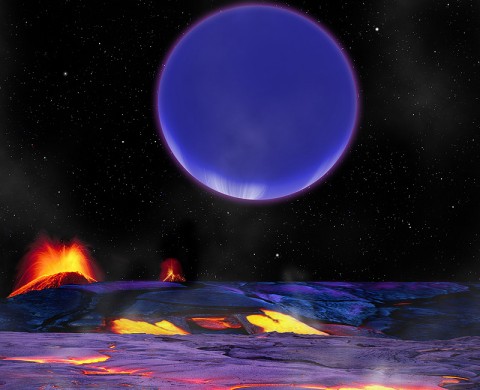Written by Whitney Clavin
NASA’s Jet Propulsion Laboratory
 Pasadena, CA – Astronomers have discovered a pair of neighboring planets with dissimilar densities orbiting very close to each other. The planets are too close to their star to be in the so-called “habitable zone,” the region in a star system where liquid water might exist on the surface, but they have the closest orbits between two planets ever confirmed.
Pasadena, CA – Astronomers have discovered a pair of neighboring planets with dissimilar densities orbiting very close to each other. The planets are too close to their star to be in the so-called “habitable zone,” the region in a star system where liquid water might exist on the surface, but they have the closest orbits between two planets ever confirmed.
The findings appeared in the journal Science.

The inner planet, Kepler-36b, orbits its host star every 13.8 days, and the outer planet, Kepler-36c, every 16.2 days. On their closest approach, the neighboring duo comes within about 1.2 million miles (1.9 million kilometers) of each other. This is only five times the Earth-moon distance and about 20 times closer to each other than any two planets in our solar system.
Kepler-36b is a rocky world measuring 1.5 times the radius, and 4.5 times the mass, of Earth. Kepler-36c is a gaseous giant measuring 3.7 times the radius, and eight times the mass, of Earth. The planetary odd couple orbits a star slightly hotter, and a couple of billion years older, than our sun. The planets are located 1,200 light-years from Earth.
To read more about the discovery, visit: the Harvard-Smithsonian Center for Astrophysics and University of Washington press releases.
Ames Research Center in Moffett Field, CA, manages Kepler’s ground system development, mission operations and science data analysis. NASA’s Jet Propulsion Laboratory, Pasadena, CA, managed the Kepler mission’s development.
The Space Telescope Science Institute in Baltimore archives, hosts and distributes Kepler science data. Kepler is NASA’s 10th Discovery Mission and is funded by NASA’s Science Mission Directorate at the agency’s headquarters in Washington. The California Institute of Technology manages JPL for NASA.
For more information about the Kepler mission, visit: http://www.nasa.gov/kepler.
More information about exoplanets and NASA’s planet-finding program is at http://planetquest.jpl.nasa.gov.


